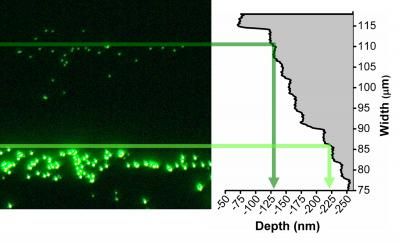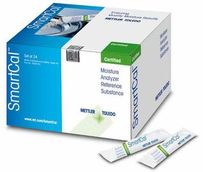NIST nanofluidic 'multi-tool' separates and sizes nanoparticles
A wrench or a screwdriver of a single size is useful for some jobs, but for a more complicated project, you need a set of tools of different sizes. Following this guiding principle, researchers at the National Institute of Standards and Technology (NIST) have engineered a nanoscale fluidic device that functions as a miniature "multi-tool" for working with nanoparticles—objects whose dimensions are measured in nanometers, or billionths of a meter.

A 3-D nanofluidic "staircase" channel with many depths was used to separate and measure a mixture of different-sized fluorescent nanoparticles. Larger (brighter) and smaller (dimmer) particles were forced toward the shallow side of the channel (fluorescence micrograph on left). The particles stopped at the "steps" of the staircase with depths that matched their sizes.
S.M. Stavis, NIST
First introduced in March 2009, the device consists of a chamber with a cascading "staircase" of 30 nanofluidic channels ranging in depth from about 80 nanometers at the top to about 620 nanometers (slightly smaller than an average bacterium) at the bottom. Each of the many "steps" of the staircase provides another "tool" of a different size to manipulate nanoparticles in a method that is similar to how a coin sorter separates nickels, dimes and quarters.
In a new article in the journal Lab on a Chip, the NIST research team demonstrates that the device can successfully perform the first of a planned suite of nanoscale tasks—separating and measuring a mixture of spherical nanoparticles of different sizes (ranging from about 80 to 250 nanometers in diameter) dispersed in a solution. The researchers used electrophoresis—the method of moving charged particles through a solution by forcing them forward with an applied electric field—to drive the nanoparticles from the deep end of the chamber across the device into the progressively shallower channels. The nanoparticles were labeled with fluorescent dye so that their movements could be tracked with a microscope.
As expected, the larger particles stopped when they reached the steps of the staircase with depths that matched their diameters of around 220 nanometers. The smaller particles moved on until they, too, were restricted from moving into shallower channels at depths of around 110 nanometers. Because the particles were visible as fluorescent points of light, the position in the chamber where each individual particle was stopped could be mapped to the corresponding channel depth. This allowed the researchers to measure the distribution of nanoparticle sizes and validate the usefulness of the device as both a separation tool and reference material. Integrated into a microchip, the device could enable the sorting of complex nanoparticle mixtures, without observation, for subsequent application. This approach could prove to be faster and more economical than conventional methods of nanoparticle sample preparation and characterization.
The NIST team plans to engineer nanofluidic devices optimized for different nanoparticle sorting applications. These devices could be fabricated with tailored resolution (by increasing or decreasing the step size of the channels), over a particular range of particle sizes (by increasing or decreasing the maximum and minimum channel depths), and for select materials (by conforming the surface chemistry of the channels to optimize interaction with a specific substance). The researchers are also interested in determining if their technique could be used to separate mixtures of nanoparticles with similar sizes but different shapes—for example, mixtures of tubes and spheres.
Original publication: S.M. Stavis, J. Geist and M. Gaitan; "Separation and metrology of nanoparticles by nanofluidic size exclusion"; Lab on a Chip, forthcoming, August 2010
Topics
Organizations
Other news from the department science
These products might interest you

Starna by Starna Scientific
Highest quality precision quartz and glass cuvettes for all applications
Custom and OEM options. All popular cells available from stock!

Certified Reference Materials for Spectroscopy by Starna Scientific
Starna Scientific: Your solution for precise spectroscopy calibration
ISO-certified reference materials for accurate and safe spectroscopy

Certified reference materials of the European Commission's Joint Research Centre by ERM
Certified reference materials for the analysis of environmental,food,clinical and industrial samples
Certified reference materials (CRMs) provide confidence in the correctness of analytical results

SmartCal by Mettler-Toledo
SmartCal verifies Moisture Analyzer Performance in 10 minutes
Proper verification and documentation assists you to fulfill the demands of industry regulations and company audits

NanoStandard™ / MicroStandard™ by Applied Microspheres
Highly uniform polymer particle size standards, with traceable mean diameters
Traceable both to the international System of Units (SI) and NIST

Get the chemical industry in your inbox
By submitting this form you agree that LUMITOS AG will send you the newsletter(s) selected above by email. Your data will not be passed on to third parties. Your data will be stored and processed in accordance with our data protection regulations. LUMITOS may contact you by email for the purpose of advertising or market and opinion surveys. You can revoke your consent at any time without giving reasons to LUMITOS AG, Ernst-Augustin-Str. 2, 12489 Berlin, Germany or by e-mail at revoke@lumitos.com with effect for the future. In addition, each email contains a link to unsubscribe from the corresponding newsletter.
Most read news
More news from our other portals
Last viewed contents
Category:EC_1.7.1
P2X_receptor
Finally, a way to authenticate premium chocolate
Category:EC_1.7.7

Researchers design efficient low-cost system for producing power at night - Rooftop radiative cooling system could provide lighting power when solar energy is unavailable
Johnson_&_Johnson_Pharmaceutical_Research_and_Development
Alkane_stereochemistry
Photorefractive_keratectomy

Breakthrough in nanoresearch: Quantum chains in graphene nanoribbons




























































